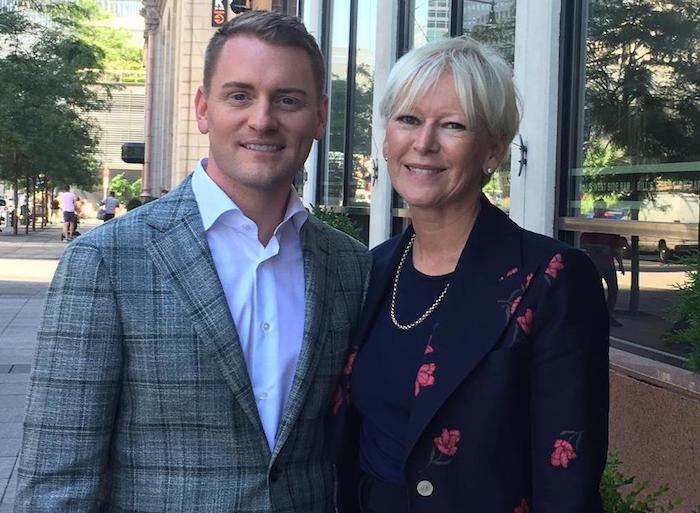Recap: PRSA Corporate Communications Section Conference
By Amy Jacques
October 2019
Joanna Coles on Transparency, Pitching and the Media
For the opening keynote, 2019 Conference Chair James Shackleford, APR, president and CEO of SomaComm, spoke with Joanna Coles, executive producer of “The Bold Type,” author of “Love Rules” and former chief content officer at Hearst Magazines. The conversation centered on journalism, branding, the state of the communications profession, digital natives and the consumer’s need for transparency.
“Public relations and communications have changed,” said Coles. “We now have to be more responsive and make decisions in a split second” with 24/7 media and social media.
“If you make a mistake, you have to apologize as quickly as you can and as authentically as you can — say sorry and move on,” she said.
“It’s one thing for people to know about a brand, but it’s another to have people engage with a brand,” Coles added. “So tell stories that people want to engage with.”
Conveying emotions via images and videos is also important, she said. Everyone needs to learn to tell stories in 2-3 seconds or less.
“Everything has changed because of our phones,” Coles said. “Don’t discount the digital native consumers and Gen Z. Pay attention and be able to mobilize your ambassadors — it can be exhilarating to watch something unfold in real-time on social media.”
When pitching someone, know what they do, want they’re looking for and what a proper partnership would look like. “No one reads press releases anymore — make them to understand the brand and understand how you can do something together,” she said.
“People love stories and ones they can relate to where the character is imperfect,” Coles said. “The media is so cluttered” — earn trust and be transparent with real stories to break through and engage consumers in this 24/7 world.
“Millennials and Gen Z would rather put burning needles in their eyes than pick up a telephone,” Coles said, noting this isn’t the best way to communicate with these generations. “Also there are too many digital conversations in the workplace and texting becomes inefficient. There’s an obsession with everyone feeling included instead of someone making a decision.”
But overall, being transparent and gaining brand trust are some of the most important parts of the communications landscape right now, Coles said.
“Consumers can sniff out inauthenticity,” so focus on being direct, open and honest.
Edelman’s Russell Dubner on the ‘State of PR & Communication Marketing’
“There’s a need for communications problem-solving: It’s important to study emerging trend sets, to consume media and keep connecting the dots, and to stay informed,” said Russell Dubner, president and CEO of Edelman U.S.
In conversation with this year’s Section Chair Kathleen Q. Sebastian (adviser, internal communications, BP) during the luncheon keynote, Dubner spoke about trust in the workforce, its impact on marketing and communications, transparency and activist employees in corporations today.
“People are looking for meaningful experiences — and all go through transformations,” in technology or communications, at their company and on a team, he said. “It’s important to talk about culture integration after changes and to find people who fit our company ethos.”
Dubner said to start your mornings by immersing yourself in the news — both online and traditional formats — and then to surround yourself with people who study the media ecosystem.
“The media isn’t dying; it’s morphing,” he said. “Keep looking for it in different places,” he said. Publications have success being niche and appealing to a specific audience, so be inventive with your visuals and social media, and keep meeting challenges.
“Know what’s going on, and then have someone share the impact of that with you,” he said. “We’re baking more social strategists into our teams.”
A few lessons he’s learned along the way (starting with his first job digging ditches for his uncle) include: Lead from the front, keep energizing your team, and be super-organized or you won’t be able to execute well and quickly.
“Communications people have insatiable curiosity. It’s important to keep consuming media — our job is to stay informed,” he continued. “Sift through stories out there and spark the imagination. Always raise your hand and give something a try” — stretch yourself and try something new.
“It’s our time as communicators to make sure we’re asking those hard questions that no one really wants to answer. We need to understand that actions are interrelated and it’s all part of narrative,” Dubner said. “People want to find meaningful work. Build trust!”
Decoding Diversity in Public Relations
“We make assumptions in about 7 seconds, but we’re often wrong,” said Shanita Baraka Akintonde, the executive vice president of marketing at UJAMAA Construction Inc.
She led conference attendees in an exercise where they talked to others at their table and asked questions to find commonalities beyond just exterior qualities they might notice at first glance like hair color, clothing, race, gender — and other assumptions that you might make about someone at the outset.
“Rhetoric is real. Stigma kills,” said Akintonde, who is also the 2019 chair of the PRSA Diversity & Inclusion Committee, as she discussed the importance of diversity in the PR practice today and looking to the future.
“Things aren’t always as they seem, so think carefully and take time before stating something,” said Akintonde.
When talking about diversity and inclusion, she said to remember the acronym ‘C.A.R.E.’
- Committing to inclusive excellence
- Advocating organizational success
- Reaching and retaining underrepresented groups
- Embodying principled leadership
“Be intentional about the images that you use in your materials,” Akintonde said. “Keep inclusiveness top of mind at work, and be mindful of stigmas and typecasting.”
When talking about diversity and inclusion at work, go through this checklist:
- Get leadership’s commitment.
- Communicate everything.
- Evaluate your organization’s needs and issues.
- Develop a leadership and retention plan.
- Emphasize competence-based credentials.
“People appreciate genuine interaction,” Akintonde said. “It’s all about diversity of thought and moving things forward.”
Seen and Heard Around the #PRSACorpComms Conference
“Before reaching out to any journalist, you must know specifically what they cover and make sure you are very targeted with your pitch.” — Aisha Al-Muslim, The Wall Street Journal
“We are too busy selling people and not serving people.” — Brandi Boatner, IBM
“When you supply the why you are much more likely to get a positive response.” — Elizabeth Edwards, Volume PR
“Content is something that has to be nurtured. Treat your content like a living organism.” — Brooke Traister, APR, Texas Instruments



